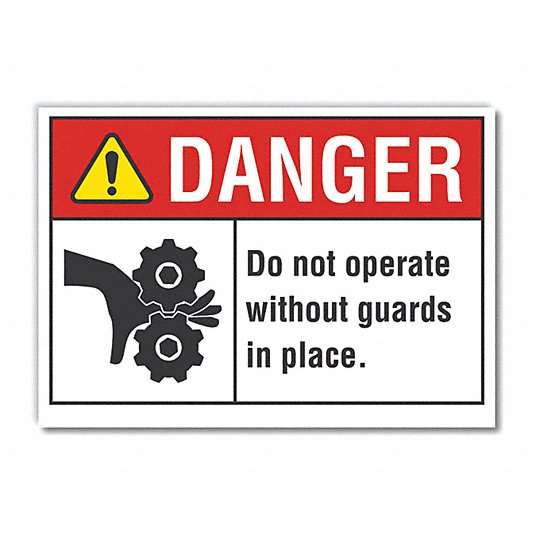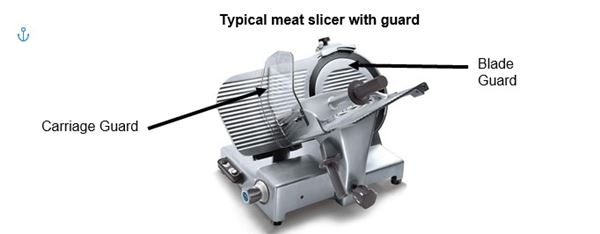Machine guarding in food premises

Do not use machine without guards
Employers have legal duties to ensure all work machinery is safe for persons to use and employees have a duty to use equipment safely. Serious injuries and fatal accidents can occur if machine guards are not used or tampered with. This page outlines the key messages for employers and looks at some commonly found catering equipment. Employers should always refer to the machines user manual as safety features and procedures may vary.
Provision and Use of Work Equipment Regulations 1998 - Approved Code of Practice and guidance covers the key points in law and sets the required standards for machinery safety.
Why is guarding important?
Working with machinery can be dangerous because moving machinery can cause injuries in many ways. Use of unguarded equipment can lead to serious injury such as crushing injuries, lacerations or in severe cases amputations or death.
If an employee was to be injured, and the equipment was unguarded, you are likely to face formal action, including prosecution.
What must employers do?
As an employer you have a legal duty to take effective measures to prevent access to dangerous machinery or stop its movement before any part of a person enters a danger zone. You will need to undertake a risk assessment to ensure the machine is safe to use. This is especially important if you are using old second hand equipment or imported equipment as they might not meet the current day required standards for this country.
How do I know if my equipment needs a guard?
Refer to the instruction manual for your equipment, if you don’t have one contact the manufacturer or supplier of the equipment. Many manuals can be found on-line and downloaded for free.
Inspect your equipment to see if a person can come into contact with dangerous parts during normal use (Dangerous parts may include; blades, rollers, belts etc. which may trap or draw in, crush or cut parts of a person).
Look to see if there are screw holes or mounting points on the equipment that do not appear to have a function. These are often a sign a guard has been removed and not replaced
How can I find a new guard for my equipment?
Contact the manufacturer of the machine or an approved supplier and obtain the correct guard.
Some employers often try to make or purchase cheaper guards to save money. These guards are usually not suitable and you will be made to purchase the correct guards.
What will happen if my equipment remains unguarded?
Employers found to be using the equipment without an appropriate guarding system in place are likely to have formal action taken against them. Health and Safety Inspectors have served many Prohibition Notices on unguarded equipment. In some circumstances the unguarded equipment is seized and removed from the business.
Using equipment without a guard is an offence and therefore you may also be prosecuted.
Ten key steps to machinery safety
- Check the machine guards are in place and working prior to starting work. If a guard is missing or defective do not use the machine.
- Check that switches and interlocking devices are working prior to starting work. If switches or interlocking devices are not working, do not use the machine.
- Do not tamper with guards in any way.
- Do not tamper with switches or interlocking guards to speed up a job, this could lead to a serious injury.
- Only persons who are trained and authorised to use that specific machine should do so.
- Wear safe and suitable clothing. Do not wear anything loose that may get caught in the machinery.
- Use any protective equipment provided by your employer
- Ensure that guards are in place, even for setting up and short runs.
- Try not to reach a part after staring the machine, follow the correct shut down procedures.
- Always replace guards after any maintenance, cleaning, setting up etc..
Planetary Mixers
Planetary/Dough mixers are slow moving but very powerful pieces of equipment. If your arm/hand or clothing become trapped by the beater serious injuries can be inflicted. Larger mixers have been known to pull persons into the mixing bowl and fatal injuries have occurred. Mixers typically have an 'interlocking guard', this means that when the guard is lifted or opened, that beaters will stop working.

You should:
- Maintain equipment in a safe working condition to prevent faulty operation.
- Inspect and test safety features daily; ensure all guards are in place and the interlocking mechanism is working.
- Ensure you have safe working procedures for staff to follow.
- Ensure all staff are trained in the safe working procedures before they are allowed to use the mixer.
- Ensure no staff put their hands or a tool into the mixer bowl whilst the mixer is in motion.
- When stopping the mixer, the mixer arm will continue to briefly operate, staff should wait for the beaters to come to a complete standstill before putting hands into the bowl.
Leaflet: Dough Mixers - Although written in New Zealand the hazards and controls remain the same as in the UK.
Video: Health and Safety Hobart Mixer
Dough rollers
There have been a number of injuries to employees who have used dough rollers. These typically involve employees hands becoming trapped by the dough rollers, and often the fire brigade is required to safely free the trapped hands. Typical injuries are usually broken or dislocated fingers and crushed muscle tissue.
The plastic guards on the dough rollers can be difficult to take off and put on and can be easily broken. You should never operate a dough roller without the guards. Because the guards are plastic they break easily. We would recommend keeping a set of spare guards for the dough roller in case the guards are damaged during maintenance or cleaning. If the guards are damaged you must not use the dough roller, use a rolling pin instead!

You should:
- Ensure all nip and trap points are guarded to avoid injury to hands or fingers.
- Maintain equipment in a safe working condition to prevent faulty operation.
- Inspect and test safety features daily; ensure all guards are in place and not broken.
- Ensure you have safe working procedures for staff to follow, especially in the case of dough becoming trapped by the rollers.
- Ensure all staff are trained in the safe working procedures before they are allowed to use the dough roller.
Meat Slicers
Meat slicers are frequently found in delicatessens and butchers and are a quick and convenient way to slice meat. However the blades are very sharp and can cause serious lacerations if safety procedures are not followed.

You should:
- Maintain equipment in a safe working condition to prevent faulty operation.
- Inspect and test safety features daily; ensure all guards are in place and not broken.
- Ensure you have safe working procedures for staff to follow, especially in the case of dough becoming trapped by the rollers.
- Ensure all staff are trained in the safe working procedures before they are allowed to use the meat slicer.
- Ensure staff focus on the task and watch what is happening
- Ensure staff never push the meat with their bare hands
- Ensure staff never lean across the slicer, it should be turned off and staff should then walk around.
- Ensure the blade is 'locked' or turned to zero when not in use.
- Ensure staff are trained in the safe cleaning of the meat slicer and that a blade carrier is available should your model of slicer require one.
Other equipment
Pastry/Dough Brake
Leaflet: Dough Brake - Although written in New Zealand the hazards and controls remain the same as in the UK
Video: Health and Safety Pastry Brake
Dough Dividers
Leaflet: Dough Divider - Although written in New Zealand the hazards and controls remain the same as in the UK.
Band Saw
Leaflet: Band Saw - Although written in New Zealand the hazards and controls remain the same as in the UK.
Work equipment - frequently asked questions
The HSE have complied a list of frequently asked questions relating to work equipment.
Last updated: 16 August 2024
